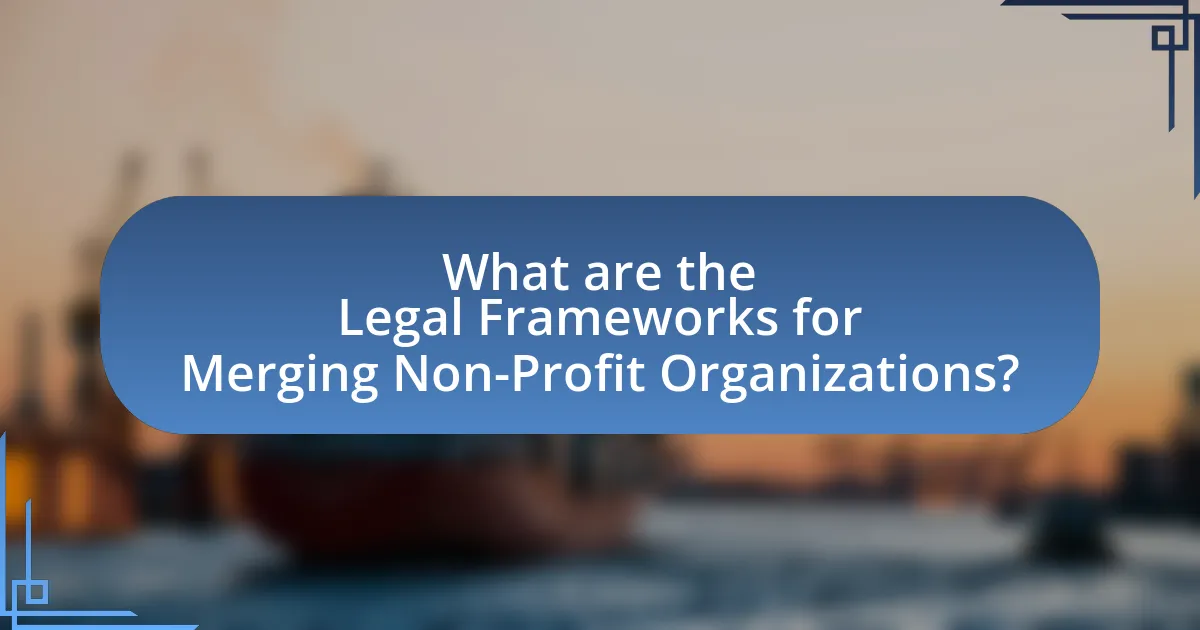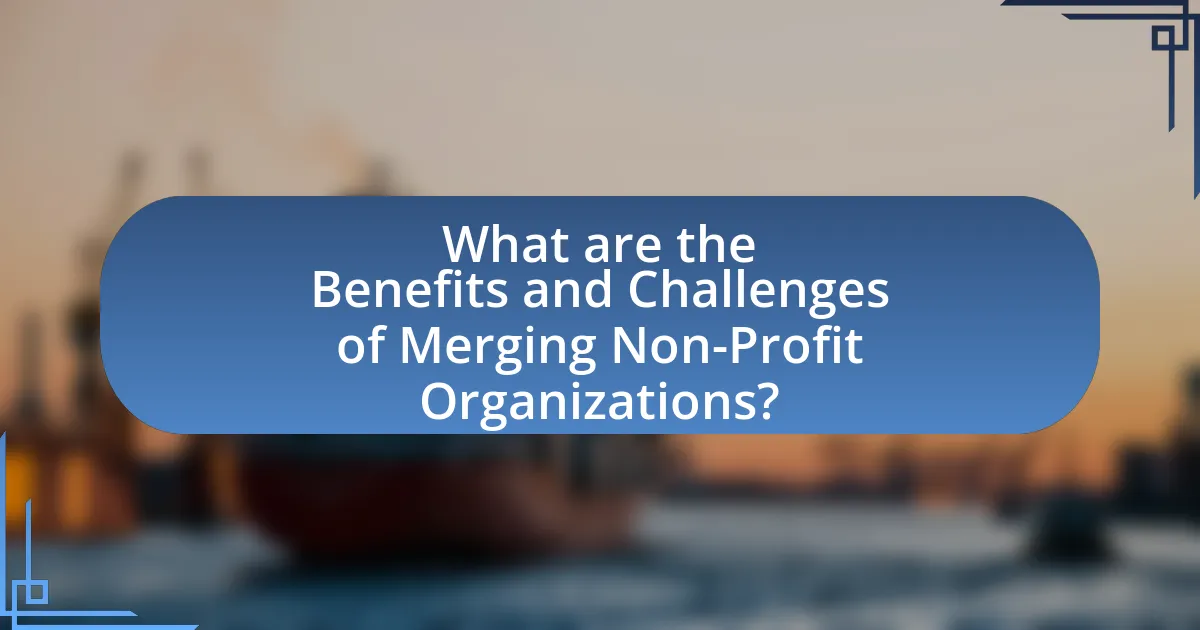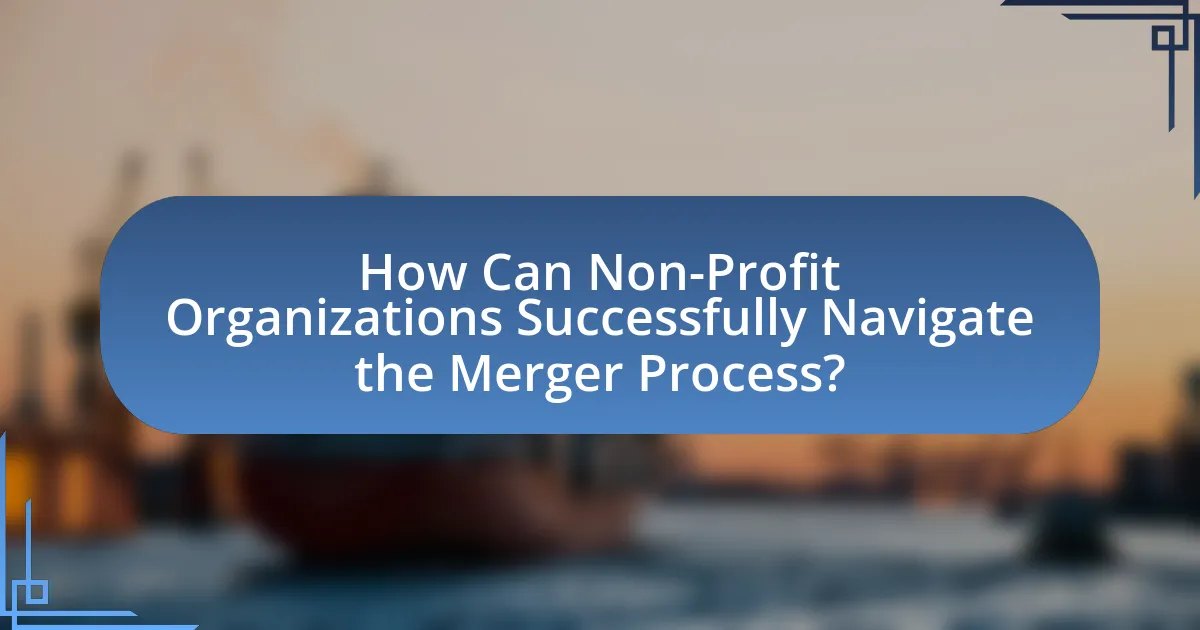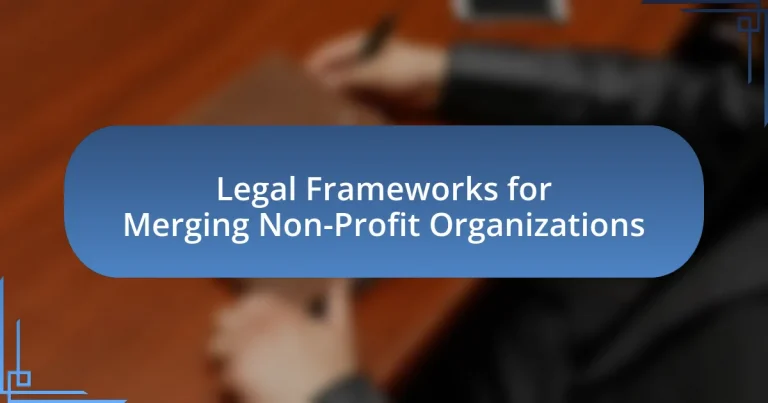The article focuses on the legal frameworks governing the merger of non-profit organizations, detailing the state laws that dictate merger procedures, including approval processes, asset distribution, and compliance with regulatory requirements. It examines how these legal frameworks impact the merger process, highlighting key considerations such as compliance with state and federal regulations, protection of donor intent, and the implications of different legal structures like mergers, consolidations, and affiliations. Additionally, the article discusses the benefits and challenges of merging non-profits, emphasizing the importance of effective communication, stakeholder engagement, and thorough preparation to navigate the complexities of the merger process successfully.

What are the Legal Frameworks for Merging Non-Profit Organizations?
The legal frameworks for merging non-profit organizations primarily involve state laws governing non-profit entities, which dictate the procedures for mergers, including approval processes, asset distribution, and compliance with regulatory requirements. Each state has specific statutes that outline how non-profits can merge, often requiring a formal plan of merger, board approval, and sometimes member approval, depending on the organization’s bylaws and state regulations. For instance, the Nonprofit Corporation Act in many states provides guidelines on the necessary documentation and filings required to complete a merger, ensuring that the interests of stakeholders, including donors and beneficiaries, are protected throughout the process.
How do legal frameworks impact the merger process of non-profit organizations?
Legal frameworks significantly influence the merger process of non-profit organizations by establishing the legal requirements and procedures that must be followed. These frameworks dictate aspects such as governance structures, compliance with state and federal regulations, and the handling of assets and liabilities during the merger. For instance, non-profit organizations must adhere to the laws governing charitable organizations, which often require board approval and transparency in financial dealings. Additionally, legal frameworks may necessitate the filing of specific documents with regulatory bodies, such as the IRS, to maintain tax-exempt status post-merger. This regulatory oversight ensures that the merger aligns with the mission of the organizations involved and protects the interests of stakeholders, including donors and beneficiaries.
What are the key legal considerations in non-profit mergers?
The key legal considerations in non-profit mergers include compliance with state laws, adherence to federal tax regulations, and the protection of donor intent. Non-profit organizations must ensure that the merger complies with the specific statutes governing non-profit entities in their respective states, which often require board approval and may necessitate a formal review process. Additionally, the Internal Revenue Service mandates that non-profits maintain their tax-exempt status post-merger, which involves careful planning to ensure that the merged entity continues to operate within the confines of its charitable purpose. Furthermore, organizations must consider the implications for existing donor agreements, as merging entities must honor the intent of contributions made by donors, which can be legally binding. These considerations are critical to avoid legal disputes and ensure a smooth transition during the merger process.
How do state laws influence non-profit organization mergers?
State laws significantly influence non-profit organization mergers by establishing the legal framework and requirements for such transactions. Each state has specific statutes that govern the merger process, including the necessary approvals from boards and members, compliance with state attorney general oversight, and adherence to filing requirements with state agencies. For example, in California, the Nonprofit Corporation Law mandates that non-profits must obtain approval from their board of directors and, in some cases, from their members before proceeding with a merger. Additionally, state laws often dictate how assets are to be handled post-merger, ensuring that they are used for charitable purposes, which is a critical aspect of non-profit operations. This legal structure ensures that mergers align with public interest and regulatory standards, thereby influencing the strategic decisions of non-profit organizations considering a merger.
What types of legal structures exist for merging non-profit organizations?
The types of legal structures that exist for merging non-profit organizations include consolidation, merger, and affiliation. In a consolidation, two or more non-profits combine to form a new entity, while in a merger, one organization absorbs another, retaining its identity. Affiliation allows organizations to collaborate while maintaining separate legal identities. These structures are governed by state laws and regulations, which dictate the process and requirements for merging non-profits, ensuring compliance and protecting the interests of stakeholders.
What are the differences between mergers, consolidations, and affiliations?
Mergers, consolidations, and affiliations are distinct forms of organizational restructuring. A merger occurs when two organizations combine to form a single entity, with one organization typically absorbing the other. In contrast, a consolidation involves the creation of a new organization formed by the combination of two or more entities, resulting in the dissolution of the original organizations. Affiliations, however, refer to a relationship where organizations remain separate but collaborate or align for mutual benefit, often maintaining their individual identities and governance structures. These definitions highlight the fundamental differences in how organizations integrate or collaborate, impacting their legal and operational frameworks.
How do different legal structures affect governance in merged non-profits?
Different legal structures significantly affect governance in merged non-profits by determining the operational framework, decision-making processes, and accountability mechanisms. For instance, a merger between two 501(c)(3) organizations may lead to a unified board that must comply with IRS regulations, impacting how governance is structured and how funds are allocated. In contrast, merging a 501(c)(3) with a 501(c)(4) can complicate governance due to differing tax obligations and mission focuses, requiring careful navigation of compliance and operational alignment. Legal structures also influence stakeholder engagement, as different entities may have varying requirements for transparency and reporting, which can affect trust and collaboration among stakeholders.
What are the regulatory requirements for merging non-profit organizations?
Merging non-profit organizations requires compliance with state laws, which typically involve obtaining approval from the state attorney general and following specific procedures outlined in the organizations’ bylaws. Each state has its own regulations governing non-profit mergers, often necessitating a formal plan of merger that details the terms and conditions, as well as the purpose of the merger. Additionally, the organizations must notify their members and may need to hold a vote to approve the merger. Compliance with federal regulations, such as those from the IRS regarding tax-exempt status, is also essential to ensure that the merged entity retains its non-profit status.
What role do state and federal regulations play in the merger process?
State and federal regulations are crucial in the merger process as they establish the legal framework that governs how mergers are conducted. These regulations ensure compliance with antitrust laws, which prevent anti-competitive practices, and require organizations to submit merger proposals for review by regulatory bodies such as the Federal Trade Commission and state attorneys general. For example, the Hart-Scott-Rodino Antitrust Improvements Act mandates that certain mergers be reported to the FTC and the Department of Justice for antitrust evaluation, ensuring that the merger does not substantially lessen competition or create a monopoly. Additionally, state laws may impose specific requirements for non-profit organizations, such as obtaining approval from state regulators or following particular procedures to protect the interests of stakeholders.
How can non-profits ensure compliance during a merger?
Non-profits can ensure compliance during a merger by conducting thorough due diligence, which involves reviewing legal, financial, and operational aspects of both organizations. This process helps identify any potential liabilities, regulatory requirements, and compliance issues that may arise from the merger. Additionally, non-profits should engage legal counsel experienced in non-profit law to navigate state and federal regulations, ensuring adherence to the laws governing mergers, such as obtaining necessary approvals from boards and state authorities. Furthermore, they must communicate transparently with stakeholders, including donors and employees, to maintain trust and comply with any contractual obligations.

What are the Benefits and Challenges of Merging Non-Profit Organizations?
Merging non-profit organizations offers benefits such as increased resources, enhanced service delivery, and improved operational efficiency. For instance, a merger can combine funding sources and donor bases, allowing for greater financial stability and the ability to tackle larger projects. Additionally, merging can lead to a more comprehensive range of services for beneficiaries, as organizations can pool their expertise and capabilities.
However, challenges include potential cultural clashes, loss of identity, and complexities in governance. Merging organizations may face difficulties in aligning their missions and values, which can lead to internal conflict and decreased morale among staff and stakeholders. Furthermore, navigating the legal and regulatory requirements for merging can be intricate, requiring careful planning and compliance with state and federal laws governing non-profits.
What advantages do non-profit organizations gain from merging?
Non-profit organizations gain several advantages from merging, including increased operational efficiency, enhanced resource allocation, and improved service delivery. Merging allows these organizations to consolidate administrative functions, reducing overhead costs and streamlining operations. For instance, a study by the Nonprofit Finance Fund found that merged organizations often experience a 20-30% reduction in administrative expenses, enabling them to allocate more resources directly to their missions. Additionally, merging can lead to a broader reach and greater impact, as combined organizations can serve a larger population and leverage diverse expertise. This strategic collaboration often results in improved program offerings and increased funding opportunities, as funders are more likely to support larger, more impactful entities.
How can merging enhance operational efficiency for non-profits?
Merging can enhance operational efficiency for non-profits by consolidating resources, reducing administrative costs, and streamlining operations. When two or more non-profits merge, they can eliminate duplicate services and administrative functions, leading to significant cost savings. For instance, a study by the Bridgespan Group found that merged organizations often experience a 20-30% reduction in overhead costs, allowing more funds to be directed toward mission-driven activities. Additionally, merging can improve service delivery by combining expertise and expanding reach, ultimately increasing the impact of the organization.
What impact does merging have on funding and resource allocation?
Merging non-profit organizations typically leads to a reallocation of funding and resources, often resulting in increased efficiency and enhanced financial stability. When two or more organizations merge, they can consolidate their funding sources, which may lead to a larger pool of available resources. For instance, a study by the Nonprofit Finance Fund in 2020 indicated that merged organizations often experience a 20% increase in funding due to combined donor bases and shared grant opportunities. Additionally, resource allocation becomes more strategic, as merged entities can eliminate redundancies and focus on core missions, thereby optimizing operational costs and improving service delivery.
What challenges do non-profit organizations face during mergers?
Non-profit organizations face several challenges during mergers, including cultural integration, financial alignment, and regulatory compliance. Cultural integration is often difficult as merging organizations may have differing missions, values, and operational styles, which can lead to conflicts and employee dissatisfaction. Financial alignment poses a challenge as organizations must reconcile different funding sources, financial practices, and budgetary constraints, which can complicate the merger process. Regulatory compliance is critical, as non-profits must navigate various legal requirements and ensure that the merger adheres to state and federal laws governing non-profit organizations, which can be complex and time-consuming. These challenges can hinder the successful integration of merged entities and impact their overall effectiveness.
How can cultural differences between organizations affect the merger process?
Cultural differences between organizations can significantly impact the merger process by influencing communication, decision-making, and employee integration. For instance, organizations with hierarchical cultures may struggle to merge with those that prioritize egalitarian structures, leading to conflicts in management styles and employee expectations. Research indicates that 70% of mergers fail due to cultural clashes, highlighting the importance of aligning organizational cultures to ensure a smooth transition. Additionally, differing values and practices can create resistance among employees, affecting morale and productivity during the merger.
What are the common legal pitfalls in non-profit mergers?
Common legal pitfalls in non-profit mergers include failure to comply with state and federal regulations, inadequate due diligence, and issues related to governance and board approval. Non-profits must adhere to specific legal requirements, such as obtaining necessary approvals from state authorities and ensuring compliance with tax-exempt status regulations. Inadequate due diligence can lead to unforeseen liabilities or financial issues that may arise post-merger. Additionally, governance challenges, such as not securing proper board approval or failing to communicate effectively with stakeholders, can result in conflicts and legal disputes. These pitfalls can jeopardize the merger process and the future viability of the merged organization.

How Can Non-Profit Organizations Successfully Navigate the Merger Process?
Non-profit organizations can successfully navigate the merger process by establishing clear communication, aligning missions, and ensuring compliance with legal requirements. Effective communication among stakeholders fosters transparency and trust, which are essential for a smooth transition. Aligning missions ensures that both organizations share common goals, facilitating a unified approach to merging operations. Compliance with legal frameworks, such as state laws governing non-profit mergers, is crucial; for instance, many states require board approval and may necessitate filing specific documents with the state attorney general. These steps are supported by research indicating that successful mergers often hinge on strategic alignment and stakeholder engagement, as highlighted in studies by the Nonprofit Finance Fund.
What steps should non-profit organizations take to prepare for a merger?
Non-profit organizations should conduct thorough due diligence as the first step in preparing for a merger. This involves assessing financial health, governance structures, and operational capabilities of both organizations to identify potential synergies and challenges. Following due diligence, organizations should engage stakeholders, including board members, staff, and donors, to communicate the merger’s purpose and benefits, ensuring alignment and support.
Next, non-profits must develop a comprehensive merger plan that outlines the integration process, including timelines, roles, and responsibilities. Legal considerations are crucial; organizations should consult legal experts to navigate regulatory requirements and ensure compliance with state and federal laws governing non-profit mergers.
Finally, non-profits should create a communication strategy to inform the public and stakeholders about the merger, emphasizing the mission continuity and enhanced impact post-merger. These steps are essential for a successful merger, as evidenced by numerous case studies where thorough preparation led to smoother transitions and improved organizational effectiveness.
How can effective communication facilitate a successful merger?
Effective communication facilitates a successful merger by ensuring clarity, alignment, and trust among stakeholders. Clear communication helps to articulate the vision, goals, and benefits of the merger, which is essential for gaining buy-in from employees, board members, and donors. For instance, a study by the Bridgespan Group found that organizations that prioritize transparent communication during mergers experience a 30% higher success rate in achieving their strategic objectives. Additionally, effective communication mitigates misunderstandings and resistance, fostering a collaborative environment that is crucial for integrating operations and cultures post-merger.
What role does stakeholder engagement play in the merger process?
Stakeholder engagement is crucial in the merger process as it ensures that the interests and concerns of all parties involved are considered, leading to smoother integration and greater acceptance of the merger. Engaging stakeholders, such as employees, donors, and community members, fosters transparency and trust, which are essential for mitigating resistance and enhancing collaboration. Research indicates that effective stakeholder engagement can significantly improve merger outcomes, as seen in a study by the Stanford Social Innovation Review, which highlights that organizations that actively involve stakeholders during mergers experience higher satisfaction and retention rates.
What best practices should be followed during the merger of non-profit organizations?
During the merger of non-profit organizations, best practices include conducting thorough due diligence, ensuring transparent communication, and aligning missions and values. Conducting due diligence allows organizations to assess financial health, legal obligations, and operational compatibility, which is crucial for a successful merger. Transparent communication with stakeholders, including staff, donors, and beneficiaries, fosters trust and minimizes resistance to change. Aligning missions and values ensures that the merged entity can effectively serve its community and maintain its commitment to its cause. These practices are supported by case studies showing that successful non-profit mergers often prioritize these elements, leading to enhanced organizational effectiveness and sustainability.
How can non-profits develop a comprehensive merger plan?
Non-profits can develop a comprehensive merger plan by conducting thorough assessments of their missions, resources, and operational structures to ensure alignment and compatibility. This process involves engaging stakeholders, including board members, staff, and community members, to gather input and foster buy-in. Additionally, non-profits should perform due diligence to evaluate financial health, legal obligations, and potential liabilities of each organization involved in the merger.
Creating a detailed integration strategy is essential, outlining how the merged entity will operate, including governance structures, staffing, and programmatic alignment. Establishing clear communication plans will facilitate transparency throughout the merger process.
Research indicates that successful non-profit mergers often involve strategic planning frameworks that emphasize collaboration and shared goals, as seen in studies by the Nonprofit Finance Fund, which highlight the importance of aligning missions and resources for effective integration.
What strategies can help in managing post-merger integration?
Effective strategies for managing post-merger integration include establishing clear communication channels, aligning organizational cultures, and defining roles and responsibilities. Clear communication ensures that all stakeholders are informed and engaged, which is crucial for reducing uncertainty and resistance. Aligning organizational cultures helps in creating a cohesive environment, as studies show that cultural misalignment can lead to integration failure. Defining roles and responsibilities clarifies expectations and accountability, which is essential for operational efficiency. Research indicates that organizations that prioritize these strategies during post-merger integration experience higher success rates, as evidenced by a study published in the Harvard Business Review, which found that 70% of mergers fail due to poor integration practices.
What resources are available for non-profits considering a merger?
Non-profits considering a merger can access various resources, including legal guides, consulting services, and merger-specific toolkits. Legal guides, such as those provided by the National Council of Nonprofits, outline the legal requirements and best practices for mergers. Consulting services from organizations like Bridgespan Group offer strategic advice tailored to non-profit mergers. Additionally, merger toolkits, available from sources like the Nonprofit Finance Fund, provide step-by-step processes and templates to facilitate the merger process. These resources collectively support non-profits in navigating the complexities of merging while ensuring compliance with legal frameworks.
How can legal counsel assist in the merger process?
Legal counsel can assist in the merger process by providing essential legal guidance and ensuring compliance with applicable laws and regulations. They help in drafting and reviewing merger agreements, conducting due diligence to identify potential legal issues, and advising on the implications of the merger for stakeholders. Legal counsel also facilitates negotiations between the merging organizations, ensuring that the terms are fair and legally sound. Their expertise is crucial in navigating the complex legal landscape surrounding non-profit mergers, which often involves state and federal regulations, tax considerations, and governance issues.
What organizations provide support and guidance for non-profit mergers?
Organizations that provide support and guidance for non-profit mergers include the National Council of Nonprofits, which offers resources and best practices for merging organizations. Additionally, the Alliance for Nonprofit Management provides consulting services and tools specifically designed for non-profit mergers. The Nonprofit Finance Fund also supports these efforts by offering financial guidance and resources tailored to non-profit organizations considering mergers. These organizations are recognized for their expertise in facilitating successful non-profit mergers and ensuring compliance with legal frameworks.


